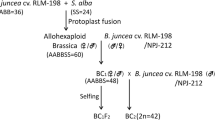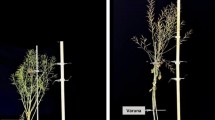Abstract
Common sunflower (i.e., Helianthus annuus) is occasionally crossed with other Helianthus species to gain favourable agronomic traits. An interspecific cross between H. annuus and Helianthus mollis was used to examine events that occurred during the five first generations. First generation hybrid plants were verified using GISH, and F1 hybrid (#17) was back-crossed to common sunflower to obtain BC1 (#4) and BC2 (#21). Some BC2 progeny possessed new traits, i.e., compact (Compact plant architecture is due to short inter-node length, short petiole length and short leaf lamina length) architecture without and with corrugated leaves, which were not observed in the parents. These traits were selected for and fixed after the BC2-S3 (#18) to produce a H. mollis introgression line (namely HM374). Although the size of the population was small, we tentatively construct a genetic map using data from the BC2 generation. Two linkage groups were identified carrying H. mollis specific AFLP markers that were associated with compact plant architecture, and one unlinked marker was shown to explain variation for the corrugated leaves. Introgression line HM374 was used to test the inheritance of compact plant architecture in a cross with an elite high oleic line, OL75HO. Microsatellite (SSR) markers were used to genotype F1 and F2 offspring’s. Our data suggested that the line HM374 was still heterozygous for introgression after eight generations. HM374 displays new architecture traits (i.e. compact architecture with or without corrugated leaves) and carries H. mollis fragments anchored on LG1 and LG11 of sunflower public map.




Similar content being viewed by others
References
Alexander MP (1969) Differential staining of aborted and non of aborted pollen. Stain Technol 44:117–122
Atlagić J, Dozet B, Škorić D (1995) Meiosis and pollen grain viability in Helianthus mollis, Helianthus salicifolius, Helianthus maximiliani and their F1 hybrids with cultivated sunflower. Euphytica 81:259–263
Besnard G, Griveau Y, Quillet M-C, Serieys H, Lambert P, Varès D, Bervillé A (1997) Specifying of introgressed regions from H .argophyllus in cultivated Sunflower (Helianthus annuus) to mark Phomopsis resistance genes. Theor Appl Genet 94:131–138
Breton C, Serieys H, Bervillé A (2010) Gene transfer from wild Helianthus to sunflower: topicalities and limits. OCL 27(2):104–114
Burke JM, Lai Z, Salmaso M, Nakazato T, Tang S, Heesacker A, Knapp SJ, Rieseberg LH (2004) Comparative mapping and rapid karyotypic evolution in the genus Helianthus. Genetics 167:449–457
Cecconi F, Gaetani M, Lenzi C, Durante M (2002) The sunflower dwarf mutant dw1: effects of gibberellic acid treatment. HELIA 25–36:161–166
Christov M (1991) Possibilities and problems in the hybridization of cultivated sunflower with species of the genus Helianthus. HELIA 19–15:35–40
Christov M, Batchvarova R, Hristova-Cherbadzhi M (2009) Wild species of Helianthus L.–sources of resistance to the parasite Orobanche cumana Wallr. HELIA 32(51):65–74
Faure N, Serieys H, Cazaux E, Bervillé A, Kaan F (2002) Occurrence of partial hybrids in wide crosses between sunflower (Helianthus annuus) and perennial CL-11 and H. orgyalis. Theor Appl Genet 104:652–660
Ge X-H, Wang J, Li Z-Y (2009) Different genome-specific chromosome stabilities in synthetic Brassica allohexaploids revealed by wide crosses with Orychophragmus. Ann Bot 104:19–31
Gedil MA, Wye C, Berry S, Segers B, Peleman J, Jones R, Leon A, Slabaugh MB, Knapp S (2001) An integrated restriction fragment length polymorphism -amplified fragment length polymorphism linkage map for cultivated sunflower. Genome 44:213–221
Heesacker AF, Bachlava E, Brunick RL, Burke JM, Rieseberg LH, Knapp SJ (2009) Karyotypic Evolution of the Common and Silverleaf Sunflower Genomes. The Plant Genome 2:233–246
Jagadeesan S, Kandasamy G, Manivannan N, Muralidharan V (2008) A valuable sunflower dwarf mutant. HELIA 31–49:79–82
Jan CC, Fernandez-Martinez JM (2002) Interspecific hybridization, gene transfer and the development of resistance to the broomrape race F in Spain. HELIA 25(36):123–135
Jan CC, Seiler G (2007) Sunflower. In: RJ Singh (ed) Oilseed crops genetic resources chromosome, engineering and crop improvement, vol 4. CRC Press, Boca Raton, pp 103–165
Jan CC, Feng JH, Seiler GJ, Gulya TJ ( 2006) Amphiploids of perennial Helianthus species x cultivated sunflower possess valuable genes for resistance to Sclerotinia stem and head rot. http://www.sunflowernsa.com/research/research-workshop/documents/JanAmphiploids_06.pdf
Jenczewski E, Gherardi M, Bonnin I, Prosperi JM, Olivieri I (1997) Insight on segregation distortions in two intraspecific crosses between annual species of Medicago (Leguminosae). Theor Appl Genet 94:682–691
Kalaidzhyan AA (2005) Sunflower mutant without petioles. Selektsiya I Semenovodstvo (Moskva) CAB abstract www.cababstracts/plusorg/abstracts/Abstractaspx?AcNo. Accessed 26 January 2011
Kim SC, Rieseberg LH (1999) Genetic architecture of species differences in annual sunflowers: implications for adaptive trait introgression. Genetics 153:965–977
Lander ES, Green P, Abrahamson J, Barlow A, Daly MJ, Lincoln SE, Newburg L (1987) Mapmaker: an interactive computer package for constructing primary genetic linkage maps of experimental and natural populations. Genomics 1:174–181
Langar K, Lorieux M, Desmarais E, Griveau Y, Gentzbittel L, Bervillé A (2003) Combined mapping of DALP and AFLP markers in cultivated sunflower using F9 recombinant inbred lines. Theor Appl Genet 106:1068–1074
Leclercq P (1978) La mutation “condensé” chez le tournesol. Ann Amél Plantes 28:447–454
Leclercq P, Cauderon Y, Dauge M (1970) Sélection pour la résistance au mildiou du tournesol à partir d’hybrides topinambour x tournesol. Ann Amél Plantes 20:363–373
Nooryazdan H, Serieys H, David J, Bacilieri R, Bervillé A (2009) Structure of wild annual sunflower (Helianthus annuus L) populations based on agro-morphological traits. Genet Res Crop Evol 57:27–39
Prabakaran AJ, Sujatha M (2004) Interspecific hybrid of Helianthus annuus × H. simulans: characterization and utilization in improvement of cultivated sunflower (H. annuus L.). Euphytica 135:275–282
Riera-Lizarazu O, Rines HW, Phillips RL (1996) Cytological and molecular characterization of oat × maize partial hybrids. Theor Appl Genet 93:123–135
Schilling EE, Heiser CB (1981) Infrageneric classification of Helianthus (Compositae). Taxon 30:393–403
Schneiter AA, Miller JF (1981) Description of sunflower growth stage. Crop Sci 21:901–903
Serieys H (1987) FAO Subnetwork report 1984–1986 In: D Škorić (ed) Genetic Evaluation and Use of Helianthus Wild Species and their Use in Breeding. Programs FAO 590 Rome Italy, pp 1–23
Škorić D, Pacureanu-Joita M, Sava E (2010) Sunflower breeding for resistance to broomrape (Orobanche cumana Wallr.). Analele I.N.C.D.A. Fundulea 78:63–79
Sossey-Alaoui K, Serieys H, Tersac M, Lambert P, Schilling E, Griveau Y, Kaan F, Bervillé A (1998) Evidence for several genomes in Helianthus. Theor Appl Genet 97:422–430
Strasburg JL, Rieseberg LH (2008) Molecular demographic history of the annual sunflowers Helianthus annuus and H petiolaris —Large effective population sizes and rates of long term gene flow. Evolution 62:1936–1950
Sujatha M, Prabakaran AJ, Dwivedi SL, Chandra SC (2008) Cytomorphological and molecular diversity in backcross-derived inbred lines of sunflower (Helianthus annuus L). Genome 51(4):282–293
Sujatha M, Liu Z, Feng J, Jan C-C (2009) Inheritance and molecular mapping of a downy mildew resistance gene, Pl (13) in cultivated sunflower ( Helianthus annuus L.). Theor Appl Genet 119:795–803
Sukno S, Ruso J, Jan CC, Melero-Vara JM, Fernández-Martínez JM (1999) Interspecific hybridization between sunflower and wild perennial Helianthus species via embryo rescue. Euphytica 106:69–78
Tang S, Knapp SJ (2003) Microsatellites uncover extraordinary diversity in native American land races and wild populations of cultivated sunflower. Theor Appl Genet 106:990–1003
Tu YQ, Sun J, Ge XH, Li Z (2010) Production and genetic analysis of partial hybrids from intertribal sexual crosses between Brassica napus and Isatis indigotica and progeny. Genome 53:146–156
Vassilevska-Ivanova R, Tcekova Z (2005) Agronomic characteristic of a dwarf germplasm sunflower line. HELIA 28(42):51–56
Wieckhorst S, Bachlava E, Dussle CM, Tang S, Gao W, Saski C, Knapp SJ, Schön C-C, Hahn V, Bauer E (2010) Fine mapping of the sunflower resistance locus PlARG introduced from the wild species Helianthus argophyllus. Theor Appl Genet 121:1633–1644
Acknowledgments
Marie Coque presently in Biogemma Inc contributed to this work by 2003. Thanks are due to Jessica Barb (The University of Georgia) for English improvements and valuable suggestions and to the sunflower team in Mauguio: Bruno Lorentz, Jean-Paul Boudon, and Catherine Weinachter-Kahane who provided excellent technical assistance..
Author information
Authors and Affiliations
Corresponding author
Electronic supplementary material
Below is the link to the electronic supplementary material.
Rights and permissions
About this article
Cite this article
Breton, C., Gil, A., Wargnier, J. et al. Transfer of architectural traits from perennial Helianthus mollis Lam. to sunflower (H. annuus L.) and localisation of introgression. Euphytica 186, 557–572 (2012). https://doi.org/10.1007/s10681-012-0656-6
Received:
Accepted:
Published:
Issue Date:
DOI: https://doi.org/10.1007/s10681-012-0656-6




